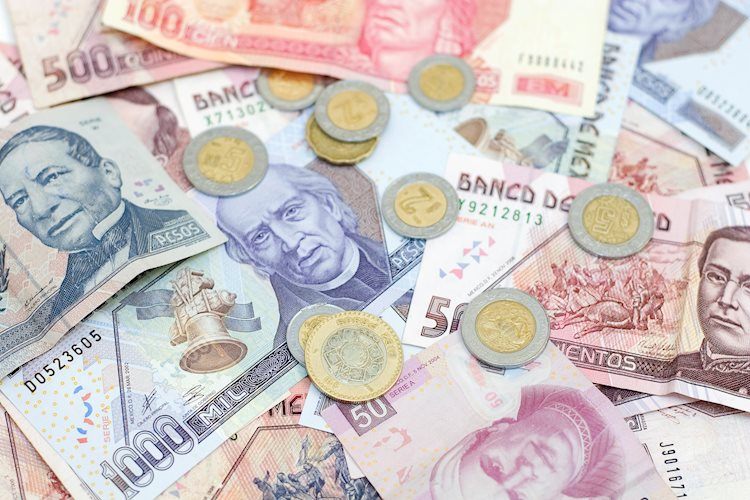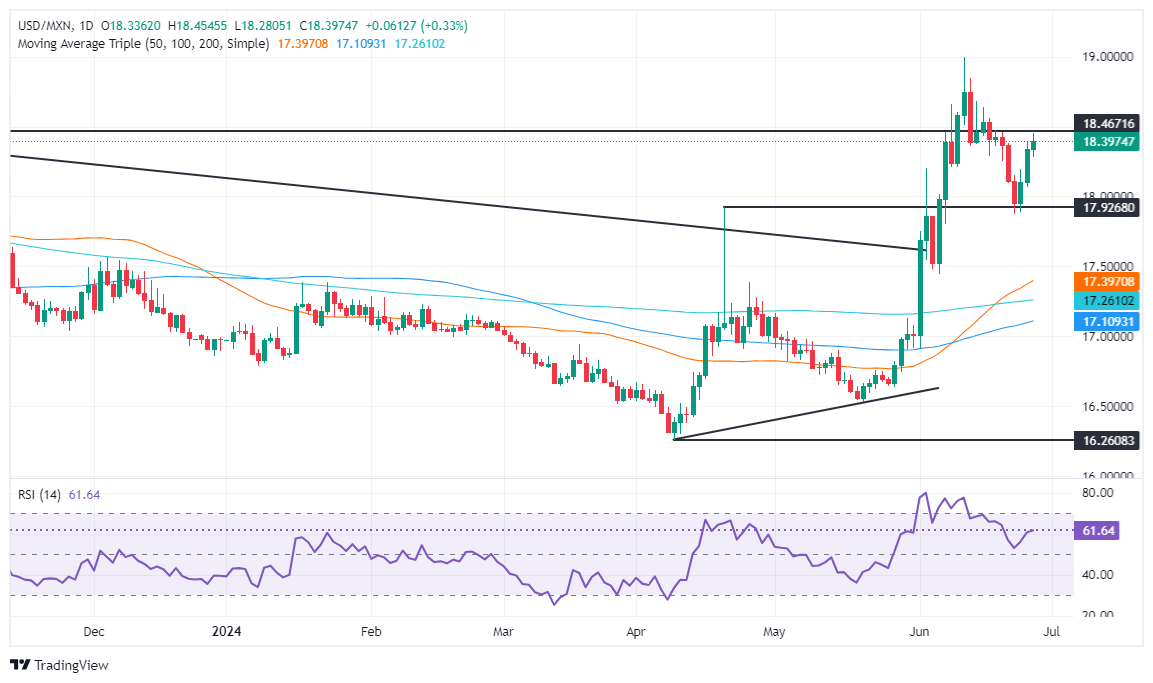- Mexican Peso remains weaker despite positive economic data.
- Banxico expected to keep rates unchanged with Citibanamex survey indicating most economists forecast no rate cut until Q3 2024.
- US data shows higher than expected Q1 GDP, lower unemployment claims, and stronger Durable Goods Orders, boosting USD.
The Mexican Peso prints minimal losses in early trading during the North American session as traders brace for the monetary policy decision of the Bank of Mexico (Banxico), scheduled for 19:00 GMT. At the time of writing, the USD/MXN trades at 18.43, up by 0.61%.
Mexico’s economic data fared better than foreseen with the Unemployment Rate coming in below estimates, while the Balance of Trade printed a surprisingly surplus. Despite that, the Mexican currency remained slightly weaker against the US Dollar (USD).
Later, Banxico is expected to keep rates unchanged, based on the latest Citibanamex survey published on June 20. Of the 31 economists polled, just nine expect a rate cut to 10.75% later, while the other 22 market participants moved their projections to the third quarter of 2024.
Across the border, mixed data in the United States (US) boosted the Greenback against most emerging market currencies but dropping against most G7 currencies. The final reading of the Gross Domestic Product (GDP) for Q1 2024 was higher than expected, unemployment claims dipped, and Durable Goods Orders exceeded forecasts.
Therefore, the USD/MXN resumed to the upside, but it remains subject to Banxico’s decision. A hold could spark a U-turn and open the door to challenge the April 19 high turned support at 18.15. Further downside would be seen, once cleared.
Otherwise, if Banxico eases policy, the exotic pair might challenge the year-to-date (YTD) high of 18.99, with further gains seen once the level is cleared.
Daily digest market movers: Mexican Peso on the defensive ahead of Banxico
- Data from Mexico, revealed the Unemployment Rate in May was 2.6%, below estimates of 2.7%. The Balance of Trade printed a surplus of $1.99 billion, crushing the consensus projections for a $-2.04 billion deficit.
- Citibanamex survey showed economists priced out fewer rate cuts by the central bank, estimating rates will be lowered to 10.25% in 2024, up from 10.00%. Regarding the USD/MXN, the consensus year-end exchange rate estimate is 18.70, up from 18.00 in the previous report.
- Regarding economic growth, the consensus revised the Gross Domestic Product (GDP) for 2024 downward from 2.2% to 2.1% YoY.
- US GDP for Q1 2024 came at 1.4% higher than the 1.3% in the previous two readings, still trailing last year’s fourth quarter of a 3.4% expansion.
- US Durable Goods Orders in May rose by 0.1% MoM, exceeding forecasts for a -0.1% contraction. At the same time, Initial Jobless Claims dipped from 239K a week ago to 233K, beneath forecasts of 236K.
- CME FedWatch Tool shows odds for a 25-basis-point Fed rate cut at 59.5% up from Wednesday’s 56.3%.
Technical analysis: Mexican Peso slides slightly as USD/MXN rallies back above 18.30
The USD/MXN is upwardly biased, yet the pair would likely remain volatile as Banxico’s decision looms. Despite that, momentum is in favor of buyers as the Relative Strength Index (RSI) suggests that bulls are in control.
For a bullish continuation, buyers need to push the USD/MXN exchange rate past the psychological 18.50 level. Once cleared, the next stop would be the year-to-date (YTD) high of 18.99, followed by the March 20, 2023, high of 19.23, followed by an uptick to 19.50.
On the flip side, if USD/MXN tumbles below the April 19 high turned support at 18.15, that will pave the way toward 18.00. Next key support level would be the 50-day Simple Moving Average (SMA) at 17.37 before testing the 200-day SMA at 17.23. Once those two levels are cleared, the next stop would be the 100-day SMA at 17.06.
Banxico FAQs
The Bank of Mexico, also known as Banxico, is the country’s central bank. Its mission is to preserve the value of Mexico’s currency, the Mexican Peso (MXN), and to set the monetary policy. To this end, its main objective is to maintain low and stable inflation within target levels – at or close to its target of 3%, the midpoint in a tolerance band of between 2% and 4%.
The main tool of the Banxico to guide monetary policy is by setting interest rates. When inflation is above target, the bank will attempt to tame it by raising rates, making it more expensive for households and businesses to borrow money and thus cooling the economy. Higher interest rates are generally positive for the Mexican Peso (MXN) as they lead to higher yields, making the country a more attractive place for investors. On the contrary, lower interest rates tend to weaken MXN. The rate differential with the USD, or how the Banxico is expected to set interest rates compared with the US Federal Reserve (Fed), is a key factor.
Banxico meets eight times a year, and its monetary policy is greatly influenced by decisions of the US Federal Reserve (Fed). Therefore, the central bank’s decision-making committee usually gathers a week after the Fed. In doing so, Banxico reacts and sometimes anticipates monetary policy measures set by the Federal Reserve. For example, after the Covid-19 pandemic, before the Fed raised rates, Banxico did it first in an attempt to diminish the chances of a substantial depreciation of the Mexican Peso (MXN) and to prevent capital outflows that could destabilize the country.


 RULE-BASED Pocket Option Strategy That Actually Works | Live Trading
RULE-BASED Pocket Option Strategy That Actually Works | Live Trading This “NEW CONCEPT” Trading Strategy Prints Money!… (INSANE Results!)
This “NEW CONCEPT” Trading Strategy Prints Money!… (INSANE Results!)
